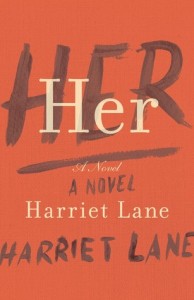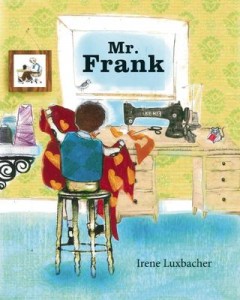April 8, 2015
Born to Walk by Dan Rubinstein
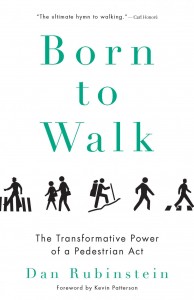 I thought I’d already read the book on walking. Rebecca Solnit’s Wanderlust: A History of Walking is one of the most fascinating books I’ve ever read, a book that opened my eyes to the wonders of rambling and tramping, and to how amazing is the ordinary world around us all the time. How extraordinary is the act of a single step, let alone one after another.
I thought I’d already read the book on walking. Rebecca Solnit’s Wanderlust: A History of Walking is one of the most fascinating books I’ve ever read, a book that opened my eyes to the wonders of rambling and tramping, and to how amazing is the ordinary world around us all the time. How extraordinary is the act of a single step, let alone one after another.
However extraordinary though, we are talking about walking. After Wanderlust, what else needs to be said? So I wasn’t entirely sold on Dan Rubinstein’s Born to Walk: The Transformative Power of a Pedestrian Act—not at least until I opened the book. I saw that Rebecca Solnit was his epigraph (“Perhaps walking is best imagined as an ‘indicator species’ to use an ecologist’s term…”). And realized that the journey, delightfully, continues on.
Whereas Solnit’s book was a history of walking, Rubinstein spreads his net wide and attempts to capture walking right now. What does it mean? How is walking changing lives and places? The book is divided into eight sections—Body, Mind, Society, Economy, Politics, Creativity, Spirit and Family—each one inspired by a central walking narrative with plenty of room for diversions. Rubsinstein, an award-winning journalist, blends memoir, sociology, psychology, cultural commentary and reporting to show how walking connects us to our fundamental selves and also to the natural world.
In “Body”, he journeys with a team led by Dr. Stanley Vollant, an Innu surgeon whose days-long hikes through the remote wilderness reconnects First Nations people with the lives their ancestors led before communities in Northern Canada became settled, hikes that are tests of physical and spiritual strength. (Aside: a quietly groundbreaking study published in 1953 asserting that “regular physical exercise could be one of the ‘ways of life’ that promote health.” More asides: modern labs which study how and why people fall, attempting to create safer stairs—”In Canada, the social and health-care cost of accidents on stairs alone is estimated at $8.8 billion a year.” An exoskeleton that enables paralyzed people to walk. So many asides: this is a text rich and enlivened by desire lines…)
In “Mind,” Rubinstein considers “The Glasgow Effect”—Glasgow has the lowest life expectancy in Western Europe, increased circumstances of psychiatric disorders—and examines programs to counter this effect including neighbourhood walks and connecting people with natural places. This chapter also uses examples of war veterans with PTSD, and the effect of hikes upon their wellbeing. In “Society,” Rubinstein travels the streets of Philadelphia with Police Officers on foot patrol, invokes Jane Jacobs, and demonstrates how different one’s experience of a city is when lived through a car window, or as part of the sidewalk ballet.
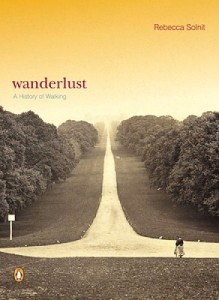 My adoration for Born to Walk was cemented with the chapter on “Economy,” which begins with a Canada Post letter carrier making her rounds in Ottawa. What do these kind of individuals offer Jacobs’ sidewalk ballet? And are people who walk for a living happier and healthier than the rest of us? Canada Post is phasing out home delivery, although they made a profit last year and their parcel delivery service is robust due to online retailers such as Amazon. Amazon, not yet fully automated—pickers at their warehouses walk 7 to 15 miles a day, Rubinstein tells us, shifting then to ask what a lack of walking costs us economically, what might be gained by created walking and cycling infrastructure. And what about the possibilities of walking and business? He addresses the walk-around management style, and the idea of walking-meetings. He also interviews two owners of a small dog-walking business. “It pays well and it’s only a half day, so I can also work on other things that I’m interested in… And yeah, the walking. That’s probably the best part.”
My adoration for Born to Walk was cemented with the chapter on “Economy,” which begins with a Canada Post letter carrier making her rounds in Ottawa. What do these kind of individuals offer Jacobs’ sidewalk ballet? And are people who walk for a living happier and healthier than the rest of us? Canada Post is phasing out home delivery, although they made a profit last year and their parcel delivery service is robust due to online retailers such as Amazon. Amazon, not yet fully automated—pickers at their warehouses walk 7 to 15 miles a day, Rubinstein tells us, shifting then to ask what a lack of walking costs us economically, what might be gained by created walking and cycling infrastructure. And what about the possibilities of walking and business? He addresses the walk-around management style, and the idea of walking-meetings. He also interviews two owners of a small dog-walking business. “It pays well and it’s only a half day, so I can also work on other things that I’m interested in… And yeah, the walking. That’s probably the best part.”
In “Politics,” Rubinstein walks with Rory Stewart, a British MP who got to know his constituents by hiking around Northwestern England, going door to door, the same way he’d got to know Afghanistan in 2002, after leaving behind his job in the Foreign Service. (His journeys through Afghanistan culminated in his book, The Places in Between.) The chapter invokes Thoreau, Gandhi, marches on Washington for woman’s suffrage and for civil rights, and First Nations walks in protest in Canada.
In “Creativity,” he takes part in walking as performance art in Brooklyn, considers artists for whom walking as served as muse or medium, and learns about the role of walking in creative cognition. In “Spirit,” he partakes in a hike through Wales, and writes about famous pilgrimages including El Camino in Spain, the Hajj in Mecca and the Kumbh Mela in northern India. He writes about what it means to finish a pilgrimage…and what it means to quit. And the final chapter is “Family,” in which he writes about walking to school with his children—particularly after they were mowed down by an SUV (and it’s always an SUV, isn’t it?) at their local crosswalk. What can we do to make streets safer for children to walk to school, for everyone to walk safely? He cites surprising benefits to walking to school—not just time for conversation and physical fitness, but studies showing that children who walk to school are more deeply connected to their communities geographically and psychologically. And he writes about walking with his children, hikes through nature—how this has always been part of their experience as a family. What it gives them: time, the moment, right now.
And that’s the thing about walking—these vast ramifications, but it often comes down to a little hand in yours, always ordinary until it comes to a tiny person’s miraculous first step.
In our family, we don’t have a car, and so the decision to walk to school isn’t one we ever have to think about. A few times a year, they have a “Walk to School Day” at the school, and we think this is funny, the same way I thought it was funny when someone declared 2014 the year to read women writers. Last year when I wrote about the Rebecca Solnit book (and its companion—the picture book The Silver Button by Bob Graham), Harriet was only 4 and finding the walk to school a bit of a struggle, whereas her legs are longer now and she’s used to it—particularly when she’s unencumbered by snow pants, the walk is not a slog at all. “I was born to walk,” she told me this morning, because she is impressionable, and can read book jackets now, and I’ve been talking a lot about this one. It’s a book whose connections to the world are so multitudinous that you keep putting it down as you’re reading to share something fascinating, and then when the book is done, you go out walking down the street, and the connections all come back to the other way.
Iris, who is not quite 2, is a different creature than her sister was, bipedally speaking. She wants to walk everywhere, shouting “Walkie! Walkie!” if we dare constrain her in her stroller, and she doesn’t just want to walk—she does walk. Last Tuesday, she walked down Bloor Street from Spadina to Bay. It’s her favourite thing in the world—she seems to know everything in Rubinstein’s book innately—to be motoring on her own steam, and so completely free.
March 31, 2015
The Big Swim by Carrie Saxifrage
 Books come from trees, and I’ve got this theory they never entirely shake their wild origins. I think this every time I’m reading outside in the spring and blossoms rain down on my book’s pages, or when a tiny midge appears and sits down at the end of a sentence. The poetry book Decomp by Stephen Collis and Jordan Scott was created from what remained of copies of Origin of Species that had been left in five distinct ecosystems to decay for a year, and I love that idea: of books and reading being so firmly embedded in nature, like they belong there. And in her extraordinary book of essays, The Big Swim, Carrie Saxifrage underlines this point, with references to literary pumpkins (Linus’s, Cinderella’s, and Peter Pumpkin Eater’s wife’s) in her essay on growing a 300 lb. squash; by recounting her grand awakening to the perils of climate change that came with reading—a series of articles by Elizabeth Kolbert; by explaining that she writes about climate change because it’s the one thing that relieves her heartbreak about understanding what we’re doing to our planet; and finally by making the natural world come alive for her reader, capturing the wonderfulness and wondrousness of nature in sparking, evocative prose.
Books come from trees, and I’ve got this theory they never entirely shake their wild origins. I think this every time I’m reading outside in the spring and blossoms rain down on my book’s pages, or when a tiny midge appears and sits down at the end of a sentence. The poetry book Decomp by Stephen Collis and Jordan Scott was created from what remained of copies of Origin of Species that had been left in five distinct ecosystems to decay for a year, and I love that idea: of books and reading being so firmly embedded in nature, like they belong there. And in her extraordinary book of essays, The Big Swim, Carrie Saxifrage underlines this point, with references to literary pumpkins (Linus’s, Cinderella’s, and Peter Pumpkin Eater’s wife’s) in her essay on growing a 300 lb. squash; by recounting her grand awakening to the perils of climate change that came with reading—a series of articles by Elizabeth Kolbert; by explaining that she writes about climate change because it’s the one thing that relieves her heartbreak about understanding what we’re doing to our planet; and finally by making the natural world come alive for her reader, capturing the wonderfulness and wondrousness of nature in sparking, evocative prose.
The next best thing to a tree for a tree to be, I’d say, would be any single page in this extraordinary book.
Rachel Carson’s Silent Spring meets Annie Dillard’s Pilgrim at Tinker Creek meets Elizabeth Gilbert’s Eat Pray Love, with a healthy dose of Barbara Kingsolver—perhaps Animal Vegetable Miracle, a book that woke me up to the wonders of eating by the season, local food movements, and that potato have greens—who knew? In 12 absorbing, funny, and thoughtful essays, Carrie Saxifrage connects the personal with the universal and the scientific to the spiritual to celebrate her love for the world and confront her anxiety about its fate.
It’s a perfect book for spring, I think. Partly because bunnies turn up twice. The first time in “Hare,” when Saxifrage writes about tensions between “tree-huggers and rednecks” on her home of Cortes Island, BC. A friend whose family has ties to the local logging industry dares to bridge the gap between the two groups, but it all gets very complicated. (There is a blockade at one point, and Saxifrage offers muffins to everyone on sides, and I do so like that she appreciates the value of the muffin as a political tool.) A long story and good intentions lead to Saxifrage dressing up as “The Easter Hare” (not the bunny, no, this is the pagan symbol for springtime fertility) for the Volunteer Firefighter’s Easter Brunch, but things go wrong as best intentions always do, and our heroine ends up locked in a bathroom with terrifying children threatening to break down the door. In the end, Saxifrage resolves to get on side with her friend’s family by “non-controversial public service” in the future. Hopefully there still can be muffins.
In “Lagomorphic Resonance,” Saxifrage is hiking alone in Washington State, the same places she’d visited years before with a friend who’d later died: “It still felt like some remnant of Paul and me, as we had been, remained in the place itself.” And she’s there to see the pikas, mouselike creatures who are cousins of rabbits and live high up on mountains, who “seem like one of the many improbable details of the world’s enormous diversity.” The essay is partly about rumours of the pika’s endangerment, threats to its habitat by rising temperatures due to climate change, partly about her anxiety as mother of a teenager (and this anxiety hangs over a lot of the text in a really interesting way), about loss and memory, and the tremendous glory of being alone in quiet places.
The essays aren’t so much about what they’re about as they’re about narrative, and so many facts, anecdotes, sidelines adding layers of meaning to the reading experience. In the title essay, Saxifrage swims five miles in the cold ocean between Cortes Island and Quadra Island, capturing the unsexy details of such an endeavour (her entire body covered in lanolin to protect against the cold) and the thrilling ones, about the pleasures of swimming and its movements, of immersion, the challenges of endurance. It’s one of the best bits of swim-lit I’ve ever read: “Romantically speaking, I’m part ocean mammal. I spend time thinking about how real mermaids would actually swim… I’m strongly related to the marine branch of the family tree.” And why does she she partake in the splendid agony of these five mile swims? Because they permit her to “belong…to a vast, cold world where brilliant seaweed banners wave in exultation.”
(So yes, my love of this book also isn’t just because of what the essays are about, but because of how the writing is so incredibly good.)
In “Pumpkin People,” Saxifrage attempts to make her way into the community on Cortes Island where she has arrived as a homesteader (and one who was previously an American lawyer, no less…) by participating in the annual ritual of growing outsized gourds; in “Hail Mary, Shining Sea” she is awakened to the reality of climate change and its threats to the planet, this idea mingling with notions of “goodness”; pursuing a low-carbon lifestyle, she and her husband eventually stop flying, and so it’s by Greyhound bus that she makes her way to Mexico for adventure and Spanish lessons and to be part of a shining sea in a metaphoric way. “Deep Blueberry Gestalt” is Saxifrage hiking through Vancouver’s Strathcona Park alone while reading Arne Naess’s ideas about “possibilism”: “that we must decisively come up with our view of life and find meaning in it, yet remember that more things are possible than we can imagine.”
In “The Oolichan and the Snake,” she attempts to understand First Nations opposition to the proposed Northern Gateway Pipeline by taking the Greyhound for 20 hours to Kitimat in Northern BC to listen to First Nation testimony. “A lot of people don’t understand how industrious our people really were,” explains Gerald Amos, an elder of the Haisla Nation. “On this river alone, we estimate that our people harvested 600 tonnes of oolichan in the springtime. This went on for untold generations. We’ve made our living here for thousands and thousands of years without destroying it.”
“Nectar” is a beautiful story of Saxifrage’s mother’s final days, and contains one of the loveliest lines I’ve ever read: “Maybe when you love someone…you are preparing for a moment you don’t even realize will come.” “Falling into Place” is about a confluence of her mother’s death with the discovery of an ancient human jawbone on their property. “Journey to Numen Land” I loved because Saxifrage decides that sleeping a lot is radical, and she attempts to draw connections between her sleeping and waking life to fascinating ends. She returns to the water in “River Creatures,” rafting through the Grand Canyon and swimming (of course!) part way, making connections between her mother, the fossilized creatures in the canyon walls and river guides who’d gone before her: “None of them got to preserve for all time what they loved, or even completely determine their own course. Like me, they had the opportunity to study the rapids, choose their path, and find joy in the river’s firm embrace.”
March 17, 2015
After Birth by Elisa Albert
No, listen, she says, the problem is no one cares about babies. I mean, they care about babies like “oh look at the cute baby” or “oh, ha ha, funny looking baby with an old man voice-over,” but no one actually cares about babies. I mean the details, it’s boring.
So let’s imagine that the ideas this book is concerned with do not matter. Let’s discuss it as a piece of literature, divorced from its subject(s). Elisa Albert’s third novel, After Birth, is an angry, passionate, gnarly and perfect mess of a novel that echoes Charlotte Perkins Gilman’s The Yellow Wallpaper in style and tone (and exclamation marks!), and also Sylvia Plath’s The Bell Jar, and more recently Claire Messud’s The Woman Upstairs for the force of its rage. Its narrator, Ari, at one point references her favourite Grace Paley story (“Wants”). Which is to say that this is a novel constructed on a strong literary tradition. Its short clipped sentences are notes and dispatches from a place of confusion, attempts to reconcile life itself with one’s expectations of it, and other realities including people’s Facebook profiles and feminist theory. The notes and dispatches do not comprise a plot so much as a circling round of a fact, a record of a winter of inertia. So what moves the book forward then? Well, voice, first—Ari’s is distinct, disturbing, unnerving, frustrating, funny and smart. Second is her vision of the world, which is peculiar and her remarkable articulation of it. And third is curiosity—something’s gotta give. Will she be broken? Will her rage be quashed? And are these two questions actually one and the same? Albert’s first-person address is so solid, so realized, that it gives the impression of having been carved out of something larger, chiseled, rather than built up from the ground. Nothing is incidental or extraneous in her prose. The book and its narrator are exhausting to encounter, frustrating, untameable, and brilliant.
2.
No, listen, though, the problem is with books, with novels about motherhood. Or even worse, those novels that purport to finally pull back the veil and “tell the truth about motherhood.” The problem, in addition to the fact that nobody cares about babies, is that a book about motherhood is rarely read (if it is read at all) as a book about a mother. Instead, it’s a manifesto. Read as a statement on an institution instead of a literary work about a fictional character. A story. We have a hard time grasping that there can be more than one story about motherhood, or if there is more than one, there’s just two then, always diametrically opposed. Two gals facing down on the cover of a magazine. One is always carrying a briefcase. When in reality, there are so many stories, and each of those stories comprise so many stories in themselves, the same way that a single day can hold more than one kind of weather.
“The buildings are amazing in this shitbox town,” is the first line of After Birth, which isn’t nuanced, but it kind of is. And readers and reviewers rarely know what to do with that.
3.
No listen, the problem is that there are the early days of motherhood, and then there is what happens a while after that, when you’ve finally got it figured out, and you feel obligated to go out and deliver everybody else from the darkness. This was the point at which I sent my cousin a completely revised version of her baby registry, when I would start to hyperventilate at the idea of a friend choosing not to co-sleep, when I wanted to chase desperate looking women down who were pushing strollers down the street and put my arms around them, promise them everything was going to be okay. Which was surely the last thing these sorry people needed. And some of them weren’t even sorry. It took me a long time to understand that.
“In the cafe where I never work on my dissertation is the woman I’ve seen at the co-op with her brand-new baby. We smile./ Do you ever feel like you’re completely losing your mind?/ Her smile fades./ It’s okay if you do. It’s perfectly normal.”
4.
No, listen, the problem is women. How we look at other women as mirrors, desperate for affirmation. But it’s always slightly unnerving to look in a mirror, and the reflection is inevitably backwards. Albert’s novel references a 1990s third-wave feminist utopia, Ani DiFranco. Dar Williams singing, “I will not be afraid of women.” But even when we’re not afraid, women are not always good to each other. Like people in general, women are like that. Perhaps more so because of the way in which we’re set up for failure in our engagement, taught to see others as opponents. Ari’s stepmother is an evil feminine archetype, her cousin becomes Bridezilla, and she herself occupied a nasty role as “the other woman” before she married her husband (though she’s not self-aware enough to interrogate this idea. Or is too much so.) She documents her history with female roommates at university, at a private girls high school, at Jewish summer camp, with not one but two moms’ groups. Women are ever disappointing.
Women are ever disappointing for a variety of reasons, both women in the book and women in the world, but part of the problem is that we’re forever looking for that mirror, for affirmation.
“Do you ever feel like you’re completely losing your mind?/ Her smile fades./ It’s okay if you do. It’s perfectly normal.”
“I’m v happy to see women engaging and disagreeing. Most necessary. Interrogation is essential,” wrote my friend Anakana Schofield in a tweet last week, in response to Jessa Crispin on Leslie Jamison’s The Empathy Exams and being tired of female pain (and I’d noted that Jamison was tired of people who were tired of it.)
I think that this is a very good point. We need to know how to look at other women without looking for our own reflection. We need to learn to disagree and not end up shattering glass.
5.
“Two hundred years ago—hell, one hundred years ago—you’d have a child surrounded by other women: your mother, her mother, sisters, cousins, sisters-in-law, mother-in-law. And you’d be a teenager too, too young to have had any kind of life yourself. You’d share childcare with a raft of women. They’d help you, keep you company, show you how.”
No, listen, the problem is we have no rafts of women. With After Birth, as with so many other books about mothers, the problem is not motherhood itself, but instead a motherhood that puts a woman apart from the world, both in practical terms (Ari is removed from familiar surroundings in a new town, isolated while her husband is oblivious and busy with his work) and theoretical ones (remember? No one cares about babies. Ari’s concerns are nobody else’s, her’s alone). Her own mother is dead (and Ari’s memories of her are rife with anger at her mother’s anger—interestingly, it doesn’t seem to occur to her to wonder what her mother was so angry about) and she has no sister. She’s estranged from her Aunt, and her from her heritage (it seems) but marrying a man who isn’t Jewish.
“Here’s the problem: we are taught nothing. / How to sew, grow food, preserve food, build things, fix things, make fires, birth babies, care for babies, feed babies, move through time, grow old, die, grieve, change, sit still, be quiet.”
Here’s another problem though: was there ever really a raft of women?
Two hundred years ago, I thought as I read this, you probably would have died.
Moreover, while Ari craves the idea of this raft of women, she has spent much of her own life setting herself adrift from any semblance of one. She doesn’t wish to be anything like her own mother, or be the same kind of mother. She sees her baby as the chance for a fresh start. She wants a natural birth, to breastfeed, to eschew all things toxic and synthetic—her mothering to be nothing like the way her own generation was mothered. She wants a link that’s wholly illusory.
After Birth is a fascinating companion to Eula Biss’s On Immunity. I couldn’t help but wonder what Ari would have done had she met a woman like Biss in one of her moms’ groups, a woman who in her book thanks the mothers with whom she’d shared the conversations and preoccupations of early motherhood: “These mothers helped me understand how expansive the questions raised by mothering really are… I am writing to and from the women who complicated the matter of immunization for me…In a culture that relishes pitting women against each other in ‘mommy wars,’ I feel compelled to leave some traces on the page of another kind of argument. This is a productive, necessary argument—an argument that does not reduce us, as the diminutive mommy implies, and does not resemble war.”
Albert too demonstrates how expansive the questions raised by mothering really are. This isn’t really a book “about” motherhood at all, but instead, motherhood is its starting point.
Like many of the women in Biss’s book, Ari feels, and indeed has been, failed by the medical establishment. Her unhappiness in motherhood she puts down to the trauma of her c-section. When her friend acknowledges the experience as a kind of rape, Ari feels gratified for just a moment. And perhaps this is the link to her maternal lineage, Ari’s own particular raft of women: her own mother died from cancer caused by drugs her grandmother had taken in pregnancy to avert miscarriage. Those same drugs had left her mother with mutilated reproductive organs so that Ari herself was only conceived and born by remarkable chance. The rape too—her grandmother was raped by Nazi soldiers during the Holocaust. Survived only, Ari tells us, by having sex with them.
Naturally, the idea of witches appeals to her, of women back in history who banded together, who possessed the wisdom of how to deliver babies and cure illness (and even vaccinate, as Biss tells us). She rescues a new friend, Mina, from the throes of early motherhood by nursing her baby, an age-old practice. The two of them set up a raft of their own, and for a time, this is everything.
(I was once so angry at having had a c-section that I was given a pamphlet for a support group that helps women heal from and grieve their c-section experiences. “What kind of bullshit is this?” I was exclaiming and my terrible husband with an evil glint in his eye said, “I think you should go.” I protested and he shrugged calmly: “You’ve been grieving your c-section for four years,” he said. My fist shook at the ceiling. “I am allowed,” I told him, “to grieve my c-section and find c-section support groups totally stupid.” You can see how Ari was someone for whom I had great empathy.)
7.
No, listen, the problem is that no one ever talks about this stuff. Or maybe that when they do talk, nobody listens. See point one: Nobody cares about babies.
“Adrienne Rich had it right. No one gives a crap about motherhood unless they can profit off it. Women are expendable and the work of childbearing, done fully, done consciously, is all-consuming. So who’s going to write about it if everyone doing it is lost forever within it?”
(Or perhaps it’s that even those who are listening have no context. [“Could it be true that one has to experience in order to understand? I have always denied this idea, and yet of motherhood, for me at least, it seems to be the case.”—Rachel Cusk, A Life’s Work].)
Here is something I love about After Birth: Albert doesn’t think that a novel about new motherhood need read like the catalogue for a hipster baby boutique. The stuff is not the stuff, she knows. Stuff is lazy shorthand. It’s a way of getting away from the point.
There is so much I love about how Albert captures the crisis of new motherhood in After Birth. (Her non-fiction piece on this in the Guardian is one of the best things I have ever read about this topic.)
“The baby books said nothing about this. Days became nights became days because nights.” And, “So the dissertation thing is pretty much a lie. But you need an identity, some interest and occupation outside having a kid, you just do. Otherwise the kid will be your sole interest and occupation, and we all know how that works out for everyone.”
And, “I did not understand how there could be no break. No rest. There was just no end to it. It went on and on and on.”
And, “When I see pregnant women, I want to take them by their shoulders and shake. I mean shake. Are you ready?”
And, “I nurse while she pumps to encourage supply. She says something about it being difficult to get out when the weather’s so shitty and I say something like yeah, winter’s a shitty time to have a baby and she says something like it’s always kind of a shitty time to have a baby though isn’t it?”
7.
The problem, sweetheart, is you.
This is a line delivered by the ghost of Ari’s bitch mother near the end of novel when Ari finally confesses, “Fine, I do hate women… They’re so obedient, traitorous. Descendants of the ones who gave up other women as witches.”
Her mother’s line is important because it’s kind of true, in particular as suggested by the novel’s final sentence. The problem is Ari, because she is a specific literary character and not a statement on womankind or motherhood (and many a commenter on Goodreads seems to have difficulty understanding this distinction). She’s a fascinating, messed-up, smart and self-destructive literary character. She doesn’t affirm anything. You will think she is wrong about a lot of things. But this doesn’t mean she’s not worth reading. In some ways, it makes her so much more worth reading than any literary character whose story can be tied up in a perfect bow.
The line is also important as a statement on motherhood though, an idea I’m still teasing out. That while indeed the problem is that women are all too isolated in early motherhood (and they are), it’s not just that other women don’t save us, but that they can’t. That every woman has to discover her own way through. Naomi Stadlen writes about this in a book called What Mothers Do that I found troubling for its simplistic notions and failure to understand maternal ambivalence, but the following passage in one of the smartest I’ve ever encountered on the subject:
“If she feels disoriented, this is not a problem requiring bookshelves of literature to put right. No, it is exactly the right state of mind for the teach-yourself process that lies ahead of her. Every time a woman has a baby she has something to learn, partly from her culture but also from her baby. If she really considered herself an expert, or if her ideas were set, she would find it very hard to adapt to her individual baby. Even after her first baby, she cannot sit back as an expert on all babies. Each child will be a little different and teach her something new. She needs to feel uncertain in order to be flexible. So, although it can feel so alarming, the ‘all-at-sea’ feeling is appropriate. Uncertainty is a good starting point for a mother. Through uncertainty, she can begin to learn.”
8.
And she does learn—this is the thing. Perhaps even Ari will. And not long after the end of the first year (which for me was when storm had ceased, I could see the shapes of things, but trauma was still so recent, and I wrote this) those early days begin to fade. Motherhood itself becomes less all-consuming (literally and figuratively), one’s rage at having a c-section or not becomes less potent, the baby becomes a human, breastfeeding is no longer such a preoccupation, sharing parental duties becomes easier, you sleep more, and it’s all less boring and shattering.
Which is to say that Elisa Albert has documented a very particular moment in motherhood in After Birth, instead of motherhood in general. And that this insistence upon specificity—in spite of her narrator’s generalized wailing in collective pronouns (which is what trips less-careful readers up, I think), in spite of the moments in which our identification with her is visceral—is the novel’s greatest strength. Specificity is what turns a political statement (and oh, this is one) into literature.
March 9, 2015
On Immunity by Eula Biss
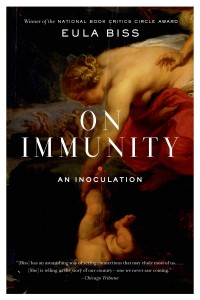 I will admit it: until recently, I was one of those parents whose children weren’t vaccinated due to my concerns about a number of toxic ingredients found in vaccines. But then when people started sharing vitriolic and expletive-filled Facebook statuses and tweets about “fucking anti-vaxxers” whose children deserved to die of smallpox, they really convinced me, and I finally came around and saw the error of my ways.
I will admit it: until recently, I was one of those parents whose children weren’t vaccinated due to my concerns about a number of toxic ingredients found in vaccines. But then when people started sharing vitriolic and expletive-filled Facebook statuses and tweets about “fucking anti-vaxxers” whose children deserved to die of smallpox, they really convinced me, and I finally came around and saw the error of my ways.
Okay, none of the above is true. First, because my children received their vaccines on schedule. But mostly because the described scenario doesn’t exist—no one’s going to change her mind in this climate. The rhetoric surrounding the vaccine “debate” is so inflamed and divisive that as it stands that there is no hope of reconciliation. I also have some sympathy for parents who doubt the safety or necessity of vaccines. While I have absolute trust in my doctor and her advice, and in the importance of vaccines for public health, I was one of the many people who put down that fear-mongering story in The Toronto Star last month on the HPV vaccine and said, “My kids are never going to get that.” And then the whole furor blew up, and I saw how we’d been played.
Which is the point at which I decided to read On Immunity by Eula Biss. Biss, poet and award-winning essayist, wades into the vaccine issue, not to seek a middle-ground—because she acknowledges that there isn’t one; the science is conclusive; her own child is vaccinated—but to seek context, to create something richer than a polemic. More than a book on “issues”, even, this is a book on language and metaphor, about how both frame the way we understand our bodies and our world, and about vaccinations and immunity might serve as a metaphor for America and the world today. “And it has vampires in it,” so notes the blurb on the back by Rebecca Solnit. Because, yes, this book is blurbed by Rebecca Solnit AND Anne Fadiman, which makes it basically a non-fiction holy book. And it is oh so very good.
Biss begins with the myths and fairytales, those stories in which “parents…have a maddening habit of getting tricked into making bad gambles with their children’s lives.” Including the myth of Achilles whose mother seeks his immortality. Biss writes, “Immunity is a myth, these stories suggest, and no mortal can ever be made invulnerable,” and considers the desperate ways in which parents seek to protect their children from their fates.
Her son was born as H1N1 panic spread across the world, around the same time my elder daughter was. I remember lining up for hours at Metro Hall downtown for the flu vaccines we were eligible for because we resided with a member of the vulnerable segment of the population. “It was not a good season for trust,” Biss writes, as financial markets were crumbling and many people were considering the response to the H1N1 panic to be overblown, a plot by big-pharma, the vaccine’s components considering dubious by many in the chattering-mother set.
Biss invokes Bram Stroker’s Dracula, a story that serves as a metaphor for disease. “What makes Dracula particularly terrifying, and what takes the plot of the story so long to resolve, is that he is a monster whose monstrosity is contagious.” And the story, she continues, is as much about the problem of evidence and truth as it is about vampires. How do we ever know what we know?
Public health, Biss notes, is rarely seen by members of the middle class as intended for “people like us.” She uses the example of prominent anti-vaccine campaigner Dr. Bob Sears who writes of the hep B vaccines, “This is an important vaccine from a public health standpoint, but it’s not as critical from an individual point of view.” Biss explains, “In order for this to make sense, one must believe that individuals are not part of the public.” But such a limited perspective is hardly novel, Biss shows shows, with historical epidemics thought to be the scourge of foreigners and outsiders (like Dracula!), and poor black people forced at gunpoint to be vaccinated in Kentucky a century ago. Historically, vaccination of those living in poverty would have benefited the wealthy, whereas the tables have now turned—the vaccination of children who live in privilege now serves to protect the vulnerable (in terms of income level and health). Biss extends her examination of this switch: “If it was meaningful for the poor [historically] to assert were not purely dangerous, I suspect it might be just as meaningful now for the rest of us to accept that we are not purely vulnerable. The middle class may be ‘threatened’, but we are still, just by virtue of having bodies, dangerous.”
But we feel threatened, we do. Here, Biss returns to poor season for trust, and explains how risk perception has more to do with fear than quantifiable risk. “Perhaps what matters,” Biss quotes the scholar Cass Sunstein has saying, “is not whether people are right on the facts but whether they are frightened.” And we certainly live in a culture of fear, which is ever heightened. Which has recently manifested in a paranoia against chemicals, countered with a strange faith that nature itself is benevolent. But vaccines, note Biss, reside where between the two: “vaccines are of that liminal place between humans and nature—a mowed field.” She further complicates the issue by using the example of the Americas’ native populations, decimated by disease after the arrival of Europeans: “Considering this course of events ‘natural’ favours the perspective of the people who subsequently colonized the land, but it fails to satisfy the ‘not made or caused by humankind’ definition of the term.”
Nothing is straightforward, and science writing, and misperceptions of science writing, skews things. Did you know that there is no causal link between DDT and cancers? I didn’t. I read Rachel Carson’s Silent Spring, her book that sparked a revolution by suggesting there is no boundary between the human body and its environment, and while this is indeed the case, and while spraying DDT from airplanes over towns and vast tracts of farmland is indeed dangerous and does irreparable damage to ecosystems, Silent Spring‘s greatest legacy, as noted by journalist Tina Rosenberg, is that it’s “killing African children because of its persistence in the public mind.” Malaria has resurged in countries where DDT is no longer used against mosquitos. While Carson recognized the utility of DDT for disease prevention, Biss writes, “the enduring power of her book owes less to its nuances than its capacity to induce horror…. Like the plot of Dracula, the drama of Silent Spring depends on emblematic oppositions.”
Biss traces the origins of vaccines to folk medicine, practiced by women until they were pushed out of their positions of power in their communities by the medical establishment (men who pushed women into unsanitary hospitals to have their babies, many of whom would die there because these doctors didn’t know to wash their hands). Biss notes the strange relationship between anti-vaccine mothers and vaccination itself, both born out of the same anti-establishment systems that seek/sought to undermine women and their intuitive knowledge vs. scientific fact. This is certainly not a story about emblematic oppositions after all. But still, not a reason to turn away from science altogether. We need science, notes Biss, via Donna Harraway. “Where it is not built on social domination, science can be liberating.”
My very favourite part of this book, whose every bit I appreciated so much, was the end-note to page 8 (and it’s a testament to the goodness of On Immunity that I read its notes in entirety. I didn’t want the book to end). Biss writes something that reads like an echo of my introduction to The M Word, about motherhood being one’s occupation and preoccupation in the early days, about all those conversations about motherhood between new mothers making sense of their world, which is also the world. And this is what I find so exciting about this book, that such a work of literature can be from those “productive and necessary” conversations.
Biss notes:
“These mothers helped me understand how expansive the questions raised by mothering really are… I am writing to and from the women who complicated the matter of immunization for me…In a culture that relishes pitting women against each other in ‘mommy wars,’ I feel compelled to leave some traces on the page of another kind of argument. This is a productive, necessary argument—an argument that does not reduce us, as the diminutive mommy implies, and does not resemble war.”
January 14, 2015
Her by Harriet Lane
UPDATE: I can’t believe I forgot to note the extraordinary ends to which Lane uses the sinister implications of classic children’s literature, including Goodnight Moon and “James James Morrison Morrison Weatherby George Dupree”. So very good.
There is such a descriptor as sippy-cup sinister.
“I’m reading a terrifying book about a woman with a newborn,” I told my husband, who went pale then, because a woman with a newborn is the most terrifying thing he’s ever known.
“I’m tired of female pain and also tired of people who are tired of it,” write Leslie Jamison in “Grand Unified: Theory of Female Pain,” from The Empathy Exams, and I sometimes feel similarly about the reading of the burdens of motherhood.
It’s a burden documented in vivid detail in Her, the second novel by journalist Harriet Lane. The novel is a mash-up, one scene after another presented from two points of view. One from Emma, recently a mother of two, in her late thirties, struggling to get the stroller up the steps as her three-year-old clamours for her attention, and the baby cries, and she contemplates her life, wondering where her once-self—a successful journalist, happy and carefree—has got to. And then the other, from Nina, who spies Emma from a distance, knows her from long ago, and becomes determined to work her way into the other woman’s life to enact some form of revenge.
To Emma, hoever, Nina—a successful painter, her own daughter nearly grown—is a saviour, always turning up at the right time, offering Emma exactly what she needs, providing a glimpse of the world outside, of the life she’d like to have. Nina is a respite from the drudgery of a schedule Emma describes as full of tasks all both so urgent and tedious, breaking the day into useless pieces, rendering the whole thing as just scraps. But why is Nina so interested in her? It’s a nagging question, but one that Emma pushes to the back of her mind, which is already overwhelmed by lack of sleep, stress, financial worries, marital strife, and general ennui. She’s so vulnerable, which Nina recognizes instantly, and realizes she can prey on.
Which makes Her so compelling, so beyond those other narratives which tire me whose only virtue is their honesty, is that the truths revealed about new motherhood are just the starting point. From here, Lane has created a psychological thriller so convincing in its reality, so ominous in its mundanity, so sippy-cup sinister in a manner I last recall reading in Emily Perkins’ excellent 2008 book, A Novel About My Wife.
Nina gets closer and closer to Emma, welcomed into her home, caring for her children, and while we know along she has nefarious intentions—presented in the alternating chapters which, like Emma’s, are written in first-person—we don’t know why she’s out to exact revenge from Emma, who doesn’t remember her at all. We don’t know either which form her revenge will take, though as the novel progresses, indicators emerge, signs and signals that are so terrifying, all hurtling towards the novel’s very end, which is completely and utterly devastating. Not to mention amazing. But don’t say I didn’t warn you.
It’s a page-turner, but the reader will be slowed by Lane’s prose, the pitch-perfect imagery and descriptions, which are to be savoured. By the nuance too, suggesting the motherhood (and everything) is a many-sided reality after all. And the reader will be chilled by Lane’s suggestion that danger lurks even in the safest of places, that the most heightened maternal vigilance might never be enough.
January 11, 2015
The Devil You Know by Elisabeth de Mariaffi
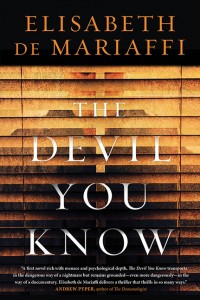 The stakes were high for Elisabeth de Mariaffi’s The Devil You Know. On Wednesday morning, I walked 2km at -25 degrees to get a copy, because I’d been hearing such good things about it and it seemed like exactly the kind of book you want to hang out with curled up warm while the blizzard howls. A mystery, a thriller, a book set in Southern Ontario during the 1980s and early ’90s, during which a series of young girls were kidnapped and sometimes found murdered, otherwise their faces depicted on posters for years afterwards under the heading, “Missing.” Years later, “aged-enhanced” images of these children would be updated, but we’d still recognize them. I’ve noticed that reviewers have been responding to the book personally, viscerally. There’s a whole generation of us haunted by these missing girls—I could plot my own history by theirs, from Nicole Morin to Alicia Ross. (I was too young to know about the disappearance and murder of Sharin’ Morningstar Keenan in 1983, though she was taken the very playground where my children play.)
The stakes were high for Elisabeth de Mariaffi’s The Devil You Know. On Wednesday morning, I walked 2km at -25 degrees to get a copy, because I’d been hearing such good things about it and it seemed like exactly the kind of book you want to hang out with curled up warm while the blizzard howls. A mystery, a thriller, a book set in Southern Ontario during the 1980s and early ’90s, during which a series of young girls were kidnapped and sometimes found murdered, otherwise their faces depicted on posters for years afterwards under the heading, “Missing.” Years later, “aged-enhanced” images of these children would be updated, but we’d still recognize them. I’ve noticed that reviewers have been responding to the book personally, viscerally. There’s a whole generation of us haunted by these missing girls—I could plot my own history by theirs, from Nicole Morin to Alicia Ross. (I was too young to know about the disappearance and murder of Sharin’ Morningstar Keenan in 1983, though she was taken the very playground where my children play.)
Evie Jones, rookie reporter and protagonist of The Devil You Know is similarly haunted, not least because she’s currently covering the Paul Bernardo case as he and his wife are arrested for the murders of Kristen French and Leslie Mahaffy in 1993. But also, in particular, because her own childhood best friend was one of the dead girls, Lianne Gagnon, whose story is a fiction conflating the cases of Keenan and Allison Parrott, who was last seen getting into a car with a strange man near Varsity Stadium eleven years before. Leanne’s killer was never found. And when a strange man begins appearing on Evie’s fire escape and elsewhere, a dark figure skirting on the periphery of her life, she begins to wonder if it’s Lianne’s killer returned and if there’s something that he wants from her. Her fears are dismissed by those around her, but she can’t shake the feeling that she’s under threat, and no wonder—her own history, and the stories of women in the world that she covers in her job, do absolutely nothing to suggest otherwise.
It is suggested—perhaps too strongly, my one criticism of this book, for the signs are there and the reader surely can read them—that Evie’s job as a crime reporter is part of her need to control the forces in her life, that she seeks out stories like Bernardo’s and the stories in missing and dead girls, in order to be in command of the narrative for once. And by those concerned for Evie’s wellbeing, it is suggested too that her need for control is a bad thing, that it’s detrimental to her mental health, and that it’s this desperation making her imagine the footsteps at the door… I mean, never mind the actual footsteps at the door.
But with Evie, de Mariaffi dares to posit instead that female agency is a salve instead of a symptom. Evie Jones is far from perfect, but she’s smart, unflinching, shameless, and brave. The hero of her own story, certainly.
In her research, employing a brand new tool called the internet, Evie starts looking back at the records of what happened to her friend, and learns that there is more to the story than she ever knew. The big picture that emerges as she puts pieces together begins to suggest that the story of Lianne’s disappearance is less random than Evie ever supposed, and that she can trace the case back to a place that’s closer to home than she can bare to imagine. And that all the trouble (and the footsteps) might not be in her head after all.
The Devil You Know is a gripping, fast-paced book that I had to be torn away from, an excellent crime book with strong female protagonists, in scintillating company with those by Laura Lippman and Gillian Flynn. But there is more to it than that. More than just nostalgia too, though it’s a part of it. de Mariaffi was long-listed for the Giller prize a couple of years ago for her short story collection, How to Get Along With Women, which included her acclaimed short story, “Kiss Me Like I’m the Last Man on Earth,” which I first read in The New Quarterly. And while it seemed like a leap for a writer to go from literary short stories to a thriller, once I began reading The Devil…, the connection seemed quite straightforward to me. Partly because of the nostalgia that infuses both the novel and the story, 1980s Toronto in startling specificity. But also because of how much short story writing sets one up to write a plot driven novel—this has never occurred to me before.
Short stories are all about atmosphere and their scenes, one moment standing in for many, representative of a broader picture. Nothing is extraneous, and so too is it with a crime novel, plot-driven, which just really means one scene after another. Though perhaps with some writers and books, the reader doesn’t notice the scene, so preoccupied is she by plot, but the scenes stand out in The Devil You Know. A gripping, fast-paced book that I had to be torn away from, and I kept noticing the scenes, which were like tiny short stories contained within. The plot is the book’s foundation, but the story rises far and large above it.
It was terrific, and definitely worth a walk in the cold.
December 16, 2014
Our Favourite Picture Books of 2014
 If I Wrote a Book About You by Stephany Aulenback and Denise Holmes
If I Wrote a Book About You by Stephany Aulenback and Denise Holmes
I love this book, whose prose is as whimsical and delightful as its illustrations. Its chief appeal is that it’s about love, and even comes close to describing that indescribable love we have for our children, but not before getting silly before it gets saccharine. The silliness is so good, and so is the word play, and the pleasure the book takes with words in general. Plus, Harriet is fascinated by this being a book about a hypothetical book, because she adores books in books. Of course she does.
 Sam and Dave Dig a Hole by Mac Barnett and Jon Klassen
Sam and Dave Dig a Hole by Mac Barnett and Jon Klassen
We have a huge stack of Jon Klassen’s books at our house, and his latest with Mac Barnett is beloved for its weirdness, its humour, its dog and its cat. It’s fun to read in the same deadpan voice as I Want My Hat Back, and it cleverly situates the reader as an omniscient force in the narrative, which is really empowering…until the very end when nobody knows what’s going on. Which is kind of amazing.
 Music is for Everyone by Jill Barber and Sydney Smith
Music is for Everyone by Jill Barber and Sydney Smith
Iris is chief music lover (and singer and drummer and bum shaker) in our household, and so she’s getting this book for Christmas, just so it can do some preaching to the choir. Smith (whom we know from Sheree Fitch’s books ) is a fabulous illustrator, and musician Barber knows what she’s talking about, so I think we’re going to have a lot of fun with this book, which explores the world of music and how all of us can play.
 Goodnight You by Genevieve Cote
Goodnight You by Genevieve Cote
The fourth book in Cote’s Piggy and Bunny series is her best yet. In it, the two friends go camping and find that courage and fear are relative things, and both friends can be a comfort to the other. It’s a good story with a surprise twist at the end, but I am really fond of how Cote creates a second canvas (ha) with the friends’ tent, on which they create shadow puppets to add tension and a whole other layer to the story. It’s a clever device, and the book is sweet and fun.
We are all besotted with Covello’s Toronto ABC, from which Iris has learned that there is indeed a tower on her horizon, and she points to it every time she goes outside. It’s a beautiful book, up to the moment, and a gorgeous celebration of our city and all our favourite places—the ROM, the Islands, streetcars, High Park, the AGO, and more. This kind of book is a perfect lesson for kids about how books connect with the world.
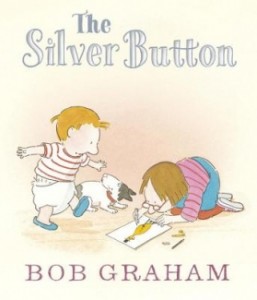 The Silver Button by Bob Graham
The Silver Button by Bob Graham
And speaking of cities, no one else writes cities in picture books quite like Bob Graham does, including the graffiti and the homeless woman pushing a shopping carts, because he wants his books to be as beautiful and complex as the world is. His latest is really wonderful, about the whole wide world and how it hinges on a single moment in which a baby takes his very first step. And I don’t just love it because I read it while I was reading Rebecca Solnit’s Wanderlust, and the connection between the two books was just uncanny.
 Julia’s House for Lost Creatures by Ben Hatke
Julia’s House for Lost Creatures by Ben Hatke
If you know Zita the Space Girl, that you’ll be thrilled to know that its creator has published his first picture book, which is as weird, wonderful and full of mystery as the Zita books. It’s about a girl called Julia whose house is on a turtle’s back, and when she settles down by the sea, she finds it all a bit too quiet. And so she opens her doors to various creatures requiring homes of their own, which brings its own complications. Being an awesome, enterprising young person, however, she figures out a way to solve her problem, and to make her house a proper home for everyone—including herself.
 Once Upon an Alphabet by Oliver Jeffers
Once Upon an Alphabet by Oliver Jeffers
This one is wrapped up and waiting under the Christmas tree, but I can’t wait to read it with Harriet. Jeffers explores the alphabet, letter by letter, imbuing each letter with a personality and life of its own. For those of us who can’t get enough of abecedarian things, the book will be sure to delight, and young readers will find it a quirky twist on their usual ABCs.
 Spic and Span by Monica Kulling
Spic and Span by Monica Kulling
Kulling’s biography of Lillian Gilbreth (who was mother of the family from Cheaper by the Dozen, not to mention a psychologist, efficiency engineer, an inventor, author and eventually a single mother to 11 children) is fascinating and Gilbreth is a great example to boys and girls that there is no limits to what a smart girl can become. Plus, she invented the shelves in your fridge door, and check out that checkerboard floor. Whoever said the domestic was dull?
I love Luxbacher’s gorgeous collage illustrations, and the sense of cultural history revealed by the story of the clothes a tailor has sewn over time—army uniforms, psychedelic mini-skirts, ripped jeans in the ’80s. But now Mr. Frank is about to sew the creation of his life—a caped ensemble that will impress those readers who are particularly enamoured with all things super-heroic. This is a super-hero story of a different sort, and a great celebration of grandparents.
Julia, Child by Kyo Maclear and Julie Morstad
Out of one kitchen and into another with this acclaimed book by a children’s literature dream team. Loosely based on the life of Julia Child and her friendship with Simca Beck (though a note advises readers to take the whole thing with a grain of salt), the story is one about the pleasures of cooking, and butter, and friendship. And to the importance of never forgetting what it is to be a child—the recipe for a happy life, perhaps?
 Peach Girl by Raymond Nakamura and Rebecca Bender
Peach Girl by Raymond Nakamura and Rebecca Bender
In Peach Girl, Nakamura turns the Japanese Momotaro folktale into a feminist celebration of feisty girldom. Momoko hatches from a peach, and then sets up to defeat an ogre in her quest to make the world a better place. She’s gutsy, unflappable, and inspires her companions. Spoilers: the ogre is just misunderstood, and they all partake in tea. Rebecca Bender’s illustrations of the Japanese countryside are stunning.
 The Secret Life of Squirrels by Nancy Rose
The Secret Life of Squirrels by Nancy Rose
Iris is still pretty choosy about books, but we have a feeling she’ll be into this one, another Christmas present. Rose’s photos of squirrels doing human things are pretty hilarious, and she’s created a fun narrative from them all. But it’s most impressive when you look in the back of the book and learn how Rose set up these photos in her own backyard (mostly by hiding nuts in her set-pieces). Iris won’t really get it though, and she’ll just like it the same way she likes the squirrels in our backyard, which she points to while shouting, “Meow!”
 The Most Magnificent Thing by Ashley Spires
The Most Magnificent Thing by Ashley Spires
This one is pretty much my ideal picture book: great images, empowered heroine who makes things, who wields a hammer, who dares to express her rage, and it all turns out okay. The takeaway too is invaluable: sometimes you have to fail in order to get anywhere. It is okay to mess up. Hard work is hard work. Perfectionism is anathema to creation. I don’t know if there is anything else I really care if my children ever learn. I love this book: the most magnificent thing indeed.
 Fisherman Through and Through by Colleen Sydor and Brooke Kerrigan
Fisherman Through and Through by Colleen Sydor and Brooke Kerrigan
It’s not often I read a picture book with a line of prose that bowls me over, but I was really struck by “…until the sun got snoozey and settled down, down on an orange cloud, toward the lip of the sea.” I love that Fisherman Through and Through is so literary—the fishermen are called Ahab, Peter and Santiago. Though the kids won’t notice that, but they’ll be compelled by this story of wishing and dreaming, and extraordinary miracles thrown up by the sea. Um, plus there is kind of a string of bunting on the cover.
December 14, 2014
2014 Books In My Head List
I feel strange about this list. First, because my reading seemed less monumental this year—I missed the blockbusters like The Goldfinch, or The Interestings. Second, my local bookshop closed, which is from where so much of my zest for reading came—I am sure I missed many books that in previous years, Book City staff would have kept neatly stacked on their new books table. And third, there are so many 2014 books I haven’t read yet. The scramble to get them all read was making me crazy, so I gave up, and now they’ll have to wait for the new year.
Luckily, books keep. Case in point: there are books here on the 2014 list that weren’t published in 2014 at all.
While this is kind of my Top Books of 2014 list, I’m thinking of it more as The Books In My Head list. The books whose reading experiences I remember so vividly, the books I kept talking about, whose characters, stories and ideas have lived on in my mind long after the last page was finally read.
In a particular order, which is alphabetical.
 Fitting though, that Caroline Adderson’s Ellen in Pieces is topper most. It may well have been. This is the book that was oddly overlooked by awards juries, and yet readers have embraced it, Ellen love-ins taking place on Twitter and Facebook quite regularly, I am finding. I have recommended it widely, and only received glowing reports back. It’s a funny, brutal, rich and challenging book. I’ve never read such an unflinching story of cancer (and love, and aging, and motherhood, and mortality). As I wrote in August, “It’s a brave take on things, really, but typical, because the exquisite nature of the entire book comes from Adderson defying her readers’ expectations, surprising you with every line, with every turn of the page.” I do think that Ellen in Pieces is THE book of the year, and you’re missing out if you haven’t read it yet.
Fitting though, that Caroline Adderson’s Ellen in Pieces is topper most. It may well have been. This is the book that was oddly overlooked by awards juries, and yet readers have embraced it, Ellen love-ins taking place on Twitter and Facebook quite regularly, I am finding. I have recommended it widely, and only received glowing reports back. It’s a funny, brutal, rich and challenging book. I’ve never read such an unflinching story of cancer (and love, and aging, and motherhood, and mortality). As I wrote in August, “It’s a brave take on things, really, but typical, because the exquisite nature of the entire book comes from Adderson defying her readers’ expectations, surprising you with every line, with every turn of the page.” I do think that Ellen in Pieces is THE book of the year, and you’re missing out if you haven’t read it yet.
Purchase Ellen in Pieces from McNally Robinson
 I read Lisa Bird-Wilson’s Just Pretending in May, starting it while we were visiting Winnipeg, and just after reading Pat Barker’s Union Street, a collection that situates the lives of working-class English women similarly to how Bird-Wilson presents First Nations women in Canada. At the time, we were promoting The M Word and it was Mother’s Day, so Bird-Wilson’s themes of motherhood resonated with me, and complicated my own understanding of these themes in my comfy middle-class context. The stories in Just Pretending portray “the wholeness of marginalized women’s experiences, experiences which hinge on maternity, on motherhood and daughterhood, and on what happens when these connections are broken,” and they’re so important now with untold stories of Canada’s Indigenous women’s experiences finally being brought to (some) light.
I read Lisa Bird-Wilson’s Just Pretending in May, starting it while we were visiting Winnipeg, and just after reading Pat Barker’s Union Street, a collection that situates the lives of working-class English women similarly to how Bird-Wilson presents First Nations women in Canada. At the time, we were promoting The M Word and it was Mother’s Day, so Bird-Wilson’s themes of motherhood resonated with me, and complicated my own understanding of these themes in my comfy middle-class context. The stories in Just Pretending portray “the wholeness of marginalized women’s experiences, experiences which hinge on maternity, on motherhood and daughterhood, and on what happens when these connections are broken,” and they’re so important now with untold stories of Canada’s Indigenous women’s experiences finally being brought to (some) light.
Purchase Just Pretending from McNally Robinson
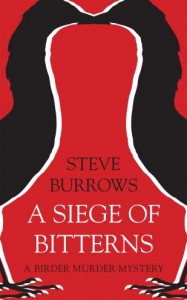 It was on Mother’s Day weekend that we visited Blue Heron Books in Uxbridge, the same day that Steve Burrows was appearing there to promote his book, A Siege of Bitterns. I was happy to buy a copy, as I’d been intrigued with his novel about a birdwatching detective, and I was so pleased to absolutely adore it. Unsurprisingly—the book has received rave reviews. The crux to the mystery’s solution involved not just birdwatching, but grammar. This book is a geek’s paradise. I’ve also been pleased to have happy readers reporting back after following my recommendation for this one. And good news: Burrows next title in the Birder Murder Mystery series is A Pitying of Doves, out this spring. I am so excited.
It was on Mother’s Day weekend that we visited Blue Heron Books in Uxbridge, the same day that Steve Burrows was appearing there to promote his book, A Siege of Bitterns. I was happy to buy a copy, as I’d been intrigued with his novel about a birdwatching detective, and I was so pleased to absolutely adore it. Unsurprisingly—the book has received rave reviews. The crux to the mystery’s solution involved not just birdwatching, but grammar. This book is a geek’s paradise. I’ve also been pleased to have happy readers reporting back after following my recommendation for this one. And good news: Burrows next title in the Birder Murder Mystery series is A Pitying of Doves, out this spring. I am so excited.
Purchase A Siege of Bitterns from McNally Robinson
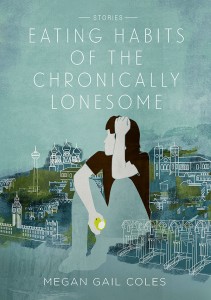 I’m so grateful to the good people at All Lit Up, without whom I might never have discovered Megan Gail Coles and her story collection Eating Habits of the Chronically Lonesome. Which contains this paragraph: “The reason Garry did these things was ’cause he couldn’t afford any better. Half of what he earned over at Pretty Paws was carted off to Newfoundland. Child support for an autistic kid he had with Slutty Marie down Gilbert Street, this the result of a one night stand./ Have you ever heard a sadder story, Dame? I mean, really? I barely poked her. We weren’t even lying down. It’s like her body sucked me sperm right inside her that night, vacuum cunt on her. Don’t ever have a go at the neighbourhood whore in an alley. Nothing good will come of it.” How could you not want to read this book?
I’m so grateful to the good people at All Lit Up, without whom I might never have discovered Megan Gail Coles and her story collection Eating Habits of the Chronically Lonesome. Which contains this paragraph: “The reason Garry did these things was ’cause he couldn’t afford any better. Half of what he earned over at Pretty Paws was carted off to Newfoundland. Child support for an autistic kid he had with Slutty Marie down Gilbert Street, this the result of a one night stand./ Have you ever heard a sadder story, Dame? I mean, really? I barely poked her. We weren’t even lying down. It’s like her body sucked me sperm right inside her that night, vacuum cunt on her. Don’t ever have a go at the neighbourhood whore in an alley. Nothing good will come of it.” How could you not want to read this book?
Purchase Eating Habits of the Chronically Lonesome from McNally Robinson
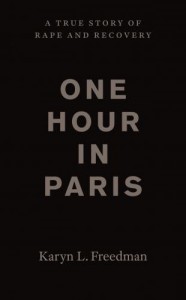 Unfortunately, as 2014 progressed, Karyn L. Freedman’s One Hour in Paris: A True Story of Rape and Recovery only became more and more important. I read it last spring as I pushed my baby in a swing. “The world, [Freedman] tells us with two decades of perspective in addition to her own violent rape, is a dangerous place for women, as statistics demonstrate in places as close as our own neighbourhoods and as far away as the war-wracked Congo. But nobody talks about these experiences, suggesting that such incidents are rare, suggesting to those lucky enough to not know better that sexual violence is a crime of circumstance, that it’s something most of us should be able to sidestep. It’s why newspaper columnists suggest that if a young woman refrains from drinking to excess, she might not get raped, and if she is raped, she should have known better. Thereby perpetuating victim’s sense of her own complicity in the crime against her, ensuring her silence, and so the cycle continues.” I’m so pleased that this book has been shortlisted for the BC National Non-Fiction Award.
Unfortunately, as 2014 progressed, Karyn L. Freedman’s One Hour in Paris: A True Story of Rape and Recovery only became more and more important. I read it last spring as I pushed my baby in a swing. “The world, [Freedman] tells us with two decades of perspective in addition to her own violent rape, is a dangerous place for women, as statistics demonstrate in places as close as our own neighbourhoods and as far away as the war-wracked Congo. But nobody talks about these experiences, suggesting that such incidents are rare, suggesting to those lucky enough to not know better that sexual violence is a crime of circumstance, that it’s something most of us should be able to sidestep. It’s why newspaper columnists suggest that if a young woman refrains from drinking to excess, she might not get raped, and if she is raped, she should have known better. Thereby perpetuating victim’s sense of her own complicity in the crime against her, ensuring her silence, and so the cycle continues.” I’m so pleased that this book has been shortlisted for the BC National Non-Fiction Award.
Purchase One Hour in Paris from McNally Robinson
 I read Mommyblogs and the Changing Face of Motherhood by May Friedman in September, and it was huge for me for all kinds of reasons. It laid the framework for the latest session of my blogging course, convinced me of the usefulness of academic theory for the very first time, and also that the history of women and blogging is one that is seriously under-documented and certainly worth telling. While Friedman’s research pertains to mommyblogs in particular (and her conclusions are always surprising, illuminating—if mommyblogs seem tired to you, she invites you to think again), it’s also hugely relevant to women and blogging in general, and is a fascinating and nuanced depiction of 21st century motherhood. And mostly, I am so struck by her notions of the usefulness of uncertainty (which reminded me of Rebecca Solnit, and ultimately led to cake): “In trying to form conclusions about mommybloggers—and about mothers—I am reminded of my children attempting to jump upon their own shadows: I am attempting to trap an essentially untrappable form of knowledge. After the initial discomfort and frustration that this inconclusive conclusion elicits, however, I have found that there is much to gained, as a researcher in general and as a motherhood researcher in particular, in looking instead at uncertainty as a valuable critical lens.” Feminism desperately needs this kind of approach, which is a fitting response to the complexity of actual people and the world.
I read Mommyblogs and the Changing Face of Motherhood by May Friedman in September, and it was huge for me for all kinds of reasons. It laid the framework for the latest session of my blogging course, convinced me of the usefulness of academic theory for the very first time, and also that the history of women and blogging is one that is seriously under-documented and certainly worth telling. While Friedman’s research pertains to mommyblogs in particular (and her conclusions are always surprising, illuminating—if mommyblogs seem tired to you, she invites you to think again), it’s also hugely relevant to women and blogging in general, and is a fascinating and nuanced depiction of 21st century motherhood. And mostly, I am so struck by her notions of the usefulness of uncertainty (which reminded me of Rebecca Solnit, and ultimately led to cake): “In trying to form conclusions about mommybloggers—and about mothers—I am reminded of my children attempting to jump upon their own shadows: I am attempting to trap an essentially untrappable form of knowledge. After the initial discomfort and frustration that this inconclusive conclusion elicits, however, I have found that there is much to gained, as a researcher in general and as a motherhood researcher in particular, in looking instead at uncertainty as a valuable critical lens.” Feminism desperately needs this kind of approach, which is a fitting response to the complexity of actual people and the world.
Purchase Mommyblogs and the Changing Face of Motherhood from McNally Robinson
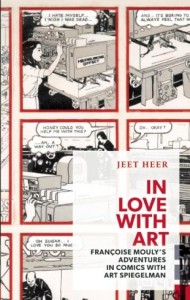 I remember reading In Love With Art by Jeet Heer on one of the first few days this spring when it was warm enough outside to walk and read without mittens, or it’s possible that it wasn’t actually that warm, but I was just enjoying the book so much. Francoise Mouly is a fascinating biographical subject, and I’d never heard of her, but unbeknownst to me, I’d seen her work—she was a long-time Art Editor of The New Yorker, and she’s the founder and Editorial Director of TOON Books, whose books we’re in love with at our house. And thisbook found its way into my (cold) hands just as Harriet was started to really get into comics, so I was pleased to learn so much about comics as an art form, and also the process behind comics creation, and what is entailed by the role of their editor. It was an excellent book, part of Coach House Books’ Exploded Views series of short books about big things, and I do love me a paperback that fits in my pocket.
I remember reading In Love With Art by Jeet Heer on one of the first few days this spring when it was warm enough outside to walk and read without mittens, or it’s possible that it wasn’t actually that warm, but I was just enjoying the book so much. Francoise Mouly is a fascinating biographical subject, and I’d never heard of her, but unbeknownst to me, I’d seen her work—she was a long-time Art Editor of The New Yorker, and she’s the founder and Editorial Director of TOON Books, whose books we’re in love with at our house. And thisbook found its way into my (cold) hands just as Harriet was started to really get into comics, so I was pleased to learn so much about comics as an art form, and also the process behind comics creation, and what is entailed by the role of their editor. It was an excellent book, part of Coach House Books’ Exploded Views series of short books about big things, and I do love me a paperback that fits in my pocket.
Purchase In Love With Art from McNally Robinson
 I only read The Bookshop That Floated Away last week, but I was so taken by Sarah Henshaw’s book, and I think that I’ll continue to be as much. We’re planning at trip to the UK in the spring, and top of my list of things to do there is tracking down the book barge. It’s the ideal book for anyone who ever thought that opening a book on a boat sounded like a perfectly sensible idea, and I loved its unabashed oddness, the absurd adventure, and all the references to books and reading, and also to Victoria Sponge Cake.
I only read The Bookshop That Floated Away last week, but I was so taken by Sarah Henshaw’s book, and I think that I’ll continue to be as much. We’re planning at trip to the UK in the spring, and top of my list of things to do there is tracking down the book barge. It’s the ideal book for anyone who ever thought that opening a book on a boat sounded like a perfectly sensible idea, and I loved its unabashed oddness, the absurd adventure, and all the references to books and reading, and also to Victoria Sponge Cake.
Purchase The Bookshop That Floated Away
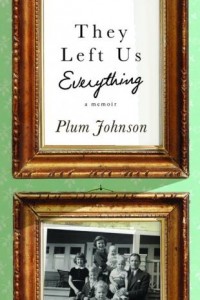 Plum Johnson’s They Left Us Everything was the most terrific memoir, ostensibly the story of a woman cleaning out her parents’ house after their deaths, but it’s also a record of a wonderful family history, about the curious shape and contents of archives and the stories they tell, about caring for aging parents, coming to terms with the past, the complexities of daughterhood and motherhood, and understanding our parents as people in their own right. I’m so pleased that it’s been nominated for the 2015 Charles Taylor Prize for Non-Fiction.
Plum Johnson’s They Left Us Everything was the most terrific memoir, ostensibly the story of a woman cleaning out her parents’ house after their deaths, but it’s also a record of a wonderful family history, about the curious shape and contents of archives and the stories they tell, about caring for aging parents, coming to terms with the past, the complexities of daughterhood and motherhood, and understanding our parents as people in their own right. I’m so pleased that it’s been nominated for the 2015 Charles Taylor Prize for Non-Fiction.
Purchase They Left Us Everything from McNally Robinson
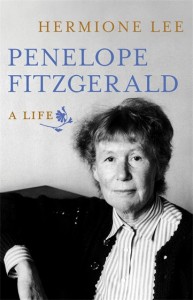 Hermione Lee’s biography, Penelope Fitzgerald: A Life, was the first book I finished in 2014, and it was how I spent my holidays—so so delightful. And anti-social. Biographers don’t come much better than Lee, and lives are rarely more interesting than Penelope Fitzgerald’s—though hers did pose a challenge for the biographer considering that all her early papers were lost when her houseboat sunk on the Thames during the 1960s (where she was living in abject poverty, barely supporting her three children. She went on to publisher her first book at age 60, won the Booker Prize at 7o). Fitzgerald’s novels had always seemed obscure to me, but their author’s life story has cast them in a new light (and I am excited for the new editions with covers by Julie Morstad).
Hermione Lee’s biography, Penelope Fitzgerald: A Life, was the first book I finished in 2014, and it was how I spent my holidays—so so delightful. And anti-social. Biographers don’t come much better than Lee, and lives are rarely more interesting than Penelope Fitzgerald’s—though hers did pose a challenge for the biographer considering that all her early papers were lost when her houseboat sunk on the Thames during the 1960s (where she was living in abject poverty, barely supporting her three children. She went on to publisher her first book at age 60, won the Booker Prize at 7o). Fitzgerald’s novels had always seemed obscure to me, but their author’s life story has cast them in a new light (and I am excited for the new editions with covers by Julie Morstad).
Purchase Penelope Fitzgerald: A Life from McNally Robinson
 And oh! Adult Onset by Ann-Marie MacDonald, the book that inspired me to write over 1300 words in response. I love how this book has been everything to everybody—I read the review that said it was about anxiety, the one that said it was about being queer, and to me it was all about motherhood. What a fascinating book that can be read through so many different lenses. I also am intrigued by the weird and wonderful ways Adult Onset flirts with genre, oh so subtly. It’s a book about parallel lives and parallel universes, ordinary city sidewalks rendered fantastic.
And oh! Adult Onset by Ann-Marie MacDonald, the book that inspired me to write over 1300 words in response. I love how this book has been everything to everybody—I read the review that said it was about anxiety, the one that said it was about being queer, and to me it was all about motherhood. What a fascinating book that can be read through so many different lenses. I also am intrigued by the weird and wonderful ways Adult Onset flirts with genre, oh so subtly. It’s a book about parallel lives and parallel universes, ordinary city sidewalks rendered fantastic.
Purchase Adult Onset by McNally Robinson
 Speaking of sidewalks, I still remember walking up Bay Street toward the subway in August reading Thunderstruck and Other Stories by Elizabeth McCracken, a hardback no-less. I was hooked from the first delicious sentence: “Just west of Boston, just north of the turnpike, the ghost of Missy Goodby sleeps curled up against the cyclone fence at the dead end of Winter Terrace, dressed in a pair of ectoplasmic dungarees.” I loved this book, and its stories: “Many of them are about grief, about the peculiarity of details during the times in life in which we’re grief-struck, or stricken at all. They’re about human connection in surprising places, about misunderstandings in which the connection is missed. Their about the things that get lost and what we choose to preserve. They’re funny even with the sadness, a many sided shape. And they’re absolutely extraordinary.”
Speaking of sidewalks, I still remember walking up Bay Street toward the subway in August reading Thunderstruck and Other Stories by Elizabeth McCracken, a hardback no-less. I was hooked from the first delicious sentence: “Just west of Boston, just north of the turnpike, the ghost of Missy Goodby sleeps curled up against the cyclone fence at the dead end of Winter Terrace, dressed in a pair of ectoplasmic dungarees.” I loved this book, and its stories: “Many of them are about grief, about the peculiarity of details during the times in life in which we’re grief-struck, or stricken at all. They’re about human connection in surprising places, about misunderstandings in which the connection is missed. Their about the things that get lost and what we choose to preserve. They’re funny even with the sadness, a many sided shape. And they’re absolutely extraordinary.”
Purchase Thunderstruck from McNally Robinson
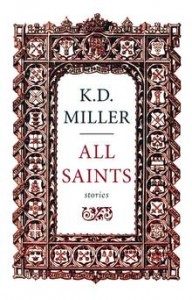 Last summer I reviewed All Saints by KD Miller in The Globe and Mail. “Most of [Miller’s characters] are searching for meaning; Miller – in language that doesn’t draw attention to itself, but bends to suit her purposes – uses the small moments in life to illuminate big questions. Where did the story start? What is destiny? Is there an order to the universe, to a life? But a life, we learn, is only a piece of the puzzle, meaning and wholeness only emerging when separate lives connect. Crucially and compellingly, such connections are mysterious – Miller shows how we are all figments of one and other’s imaginations.”
Last summer I reviewed All Saints by KD Miller in The Globe and Mail. “Most of [Miller’s characters] are searching for meaning; Miller – in language that doesn’t draw attention to itself, but bends to suit her purposes – uses the small moments in life to illuminate big questions. Where did the story start? What is destiny? Is there an order to the universe, to a life? But a life, we learn, is only a piece of the puzzle, meaning and wholeness only emerging when separate lives connect. Crucially and compellingly, such connections are mysterious – Miller shows how we are all figments of one and other’s imaginations.”
Purchase All Saints from McNally Robinson
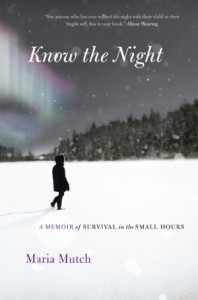 For a few weeks in February, I was deep into the memoir Know the Night by Maria Mutch, which I reviewed for The National Post, a book I read twice and puzzled through with so many notes, and figured out like a complicated math problem—so utterly engaging. All to the soundtrack of “Mercy Mercy Mercy” by Cannonball Adderley. “Know the Night, a memoir about a boy who doesn’t speak, is in love with language. Mutch’s prose is electric (when describing her relationship with her partner, she writes of “that ingredient vital for love, which can best be described, I think, as conspiracy” — my favourite line in the book) but the book is more concerned with words than the stories they tell. Mutch probes the connections between words and what they symbolize, as well as other connections for which words are a conduit.”
For a few weeks in February, I was deep into the memoir Know the Night by Maria Mutch, which I reviewed for The National Post, a book I read twice and puzzled through with so many notes, and figured out like a complicated math problem—so utterly engaging. All to the soundtrack of “Mercy Mercy Mercy” by Cannonball Adderley. “Know the Night, a memoir about a boy who doesn’t speak, is in love with language. Mutch’s prose is electric (when describing her relationship with her partner, she writes of “that ingredient vital for love, which can best be described, I think, as conspiracy” — my favourite line in the book) but the book is more concerned with words than the stories they tell. Mutch probes the connections between words and what they symbolize, as well as other connections for which words are a conduit.”
Purchase Know the Night from McNally Robinson
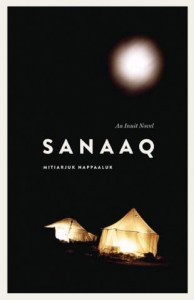 Another winter book I read around the same time was Sanaaq by Mitiarjuk Nappaaluk. Nappaaluk had been asked to write down some Inuktitut phrases for a missionary to learn, but didn’t stop at simple grammar exercises and went on invent a whole cast of characters and create the first Inuit novel. “The narrative skirts omniscience in a way that seems curious to the reader who is accustomed to the English novel. There is a matter-of-factness to the telling, perhaps related to its origins—it was written in a shorthand that can be written as quickly as it is spoken, and so this written novel has an oral nature. There is also a simplicity to its delivery that only comes across as such because a whole layer of the narrative is inaccessible to me as a reader (and I think that this is the challenge for this reader that Martin was writing about in her review). Saladin d’Anglure’s foreword makes clear that the apparent simplicity of Nappaaluk’s novel is undermined by the Inuit symbols and stories referenced, as well as details of Nappaaluk’s own life and members of her community. In short, this is only a straightforward story because I’m not smart enough to know it isn’t otherwise.”
Another winter book I read around the same time was Sanaaq by Mitiarjuk Nappaaluk. Nappaaluk had been asked to write down some Inuktitut phrases for a missionary to learn, but didn’t stop at simple grammar exercises and went on invent a whole cast of characters and create the first Inuit novel. “The narrative skirts omniscience in a way that seems curious to the reader who is accustomed to the English novel. There is a matter-of-factness to the telling, perhaps related to its origins—it was written in a shorthand that can be written as quickly as it is spoken, and so this written novel has an oral nature. There is also a simplicity to its delivery that only comes across as such because a whole layer of the narrative is inaccessible to me as a reader (and I think that this is the challenge for this reader that Martin was writing about in her review). Saladin d’Anglure’s foreword makes clear that the apparent simplicity of Nappaaluk’s novel is undermined by the Inuit symbols and stories referenced, as well as details of Nappaaluk’s own life and members of her community. In short, this is only a straightforward story because I’m not smart enough to know it isn’t otherwise.”
Purchase Sanaaq from McNally Robinson
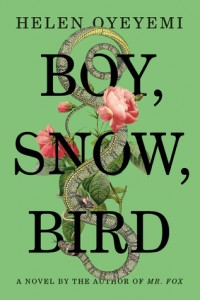 Helen Oyeyemi’s Boy Snow Bird was one of my vacation reads this summer, and I was enthralled by its twists and turns, and by how the British-born Oyeyemi channels American-ness in this novel. That it was based on a fairy tale might have had me supposing a certain shallowness to the narrative, but Oyeyemi drills down deep to show why an archetypal story like Snow White has such cultural resonance, and then introduces race as a theme to add a whole new layer of relevance. This novel was smart, sharp and gorgeous.
Helen Oyeyemi’s Boy Snow Bird was one of my vacation reads this summer, and I was enthralled by its twists and turns, and by how the British-born Oyeyemi channels American-ness in this novel. That it was based on a fairy tale might have had me supposing a certain shallowness to the narrative, but Oyeyemi drills down deep to show why an archetypal story like Snow White has such cultural resonance, and then introduces race as a theme to add a whole new layer of relevance. This novel was smart, sharp and gorgeous.
Purchase Boy, Snow, Bird from McNally Robinson
 I also adored Ruth Ozeki’s A Tale for the Time Being, which I read in April. Late to the party (because it had already been internationally celebrated by then) I read it for own pleasure, and realized it deserved all the hype. At heart, this is a novel about quantum physics, which shouldn’t scare you off. It’s a weird, wonderful story about the whole wide world, which is as terrible as it is beautiful, and it’s brilliant how Ozeki manages to knit it all together.
I also adored Ruth Ozeki’s A Tale for the Time Being, which I read in April. Late to the party (because it had already been internationally celebrated by then) I read it for own pleasure, and realized it deserved all the hype. At heart, this is a novel about quantum physics, which shouldn’t scare you off. It’s a weird, wonderful story about the whole wide world, which is as terrible as it is beautiful, and it’s brilliant how Ozeki manages to knit it all together.
Purchase A Tale for the Time Being from McNally Robinson
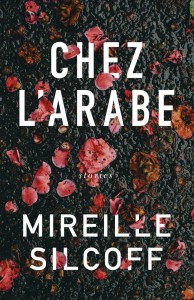 I haven’t talked much here about Chez L’Arabe by Mireille Silcoff, which I read this fall, but I loved it and my review is forthcoming in Canadian Notes & Queries. From my review: One can read Silcoff’s collection as a catalogue of beautiful well-made objects…Which is not to say that the stories lack depth, that they skim along their lush or shiny surfaces, but instead the things themselves are invested with meaning, each one “permeated with some little, important, imported world of its own.” “Materialist” is hurled as a slur more than once but, as a character replies (she of the sugar sifter), “I don’t see why anything should be considered less meaningful just because it’s concrete.””
I haven’t talked much here about Chez L’Arabe by Mireille Silcoff, which I read this fall, but I loved it and my review is forthcoming in Canadian Notes & Queries. From my review: One can read Silcoff’s collection as a catalogue of beautiful well-made objects…Which is not to say that the stories lack depth, that they skim along their lush or shiny surfaces, but instead the things themselves are invested with meaning, each one “permeated with some little, important, imported world of its own.” “Materialist” is hurled as a slur more than once but, as a character replies (she of the sugar sifter), “I don’t see why anything should be considered less meaningful just because it’s concrete.””
Purchase Chez L’Arabe from McNally Robinson
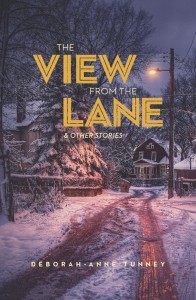 Deborah-Anne Tunney’s The View From the Lane was another recent read, but one I’ve not been able to shake off yet. It was a promising first book more than a perfect one, but a huge part of its promise is the atmosphere that Tunney creates. It reminded me of Atwood’s Cat’s Eye and Isabel Huggan’s The Elizabeth Stories in all the best ways. The night I finished this book, I stayed up late searching for the streets she writes about on Google Maps—I was left with such a sense of the place, and I wanted to see it for myself.
Deborah-Anne Tunney’s The View From the Lane was another recent read, but one I’ve not been able to shake off yet. It was a promising first book more than a perfect one, but a huge part of its promise is the atmosphere that Tunney creates. It reminded me of Atwood’s Cat’s Eye and Isabel Huggan’s The Elizabeth Stories in all the best ways. The night I finished this book, I stayed up late searching for the streets she writes about on Google Maps—I was left with such a sense of the place, and I wanted to see it for myself.
Purchase The View from the Lane by Deborah-Anne Tunney
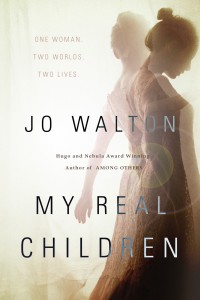 And finally, My Real Children by Jo Walton, a book I loved so very much and have given as a gift at least three times since I read it (and I replaced my ARC with a hardcover). Lots to say about this one—it connects interestingly with Lisa Bird-Wilson’s Just Pretending in its notion of real children (those we give birth to) as opposed to those who are miscarried or adopted and the “unrealness” that pervades these relationships through semantics. And with Ann-Marie MacDonald’s book, which also explores queer relationships and parallel lives. I reread this book for my book club and realized that while Walton’s strength is not as a prose stylist—there are a few lines in the book that are a bit painful to encounter—she has performed something remarkable in her creation of Patricia Cowan and her lives, so much so that this book reminded be of Hermione Lee’s Penelope Fitzgerald biography (Fitzgerald and Walton’s Patricia are near contemporaries). I’m going to be returning to this book again and again for the enthralling nature of its story, for its genre blurring and alternate histories, and for what Walton has to say about the shape and the details of an ordinary woman’s life.
And finally, My Real Children by Jo Walton, a book I loved so very much and have given as a gift at least three times since I read it (and I replaced my ARC with a hardcover). Lots to say about this one—it connects interestingly with Lisa Bird-Wilson’s Just Pretending in its notion of real children (those we give birth to) as opposed to those who are miscarried or adopted and the “unrealness” that pervades these relationships through semantics. And with Ann-Marie MacDonald’s book, which also explores queer relationships and parallel lives. I reread this book for my book club and realized that while Walton’s strength is not as a prose stylist—there are a few lines in the book that are a bit painful to encounter—she has performed something remarkable in her creation of Patricia Cowan and her lives, so much so that this book reminded be of Hermione Lee’s Penelope Fitzgerald biography (Fitzgerald and Walton’s Patricia are near contemporaries). I’m going to be returning to this book again and again for the enthralling nature of its story, for its genre blurring and alternate histories, and for what Walton has to say about the shape and the details of an ordinary woman’s life.
December 9, 2014
The Bookshop That Floated Away by Sarah Henshaw
 The trouble with being a little bit odd is that my book recommendations are not always universal, and so it is useful when I encounter a book as odd as I am, to which I can point and say, “This book is not for everyone. BUT.” Say, if you are the type who can identify with a woman who finds an injured pigeon (while travelling on her canal boat, which she has converted into a financial under-performing bookshop) and then decides to uncover all references to pigeons in the Western canon, then The Bookshop That Floated Away by Sarah Henshaw is definitely for you. It is definitely for me. My husband is a bit relieved that I’ve finally finished it, because for the past few days, I’ve been reading him passages from every other page, and while he conceded that they were indeed quite funny, he found the whole thing rather strange.
The trouble with being a little bit odd is that my book recommendations are not always universal, and so it is useful when I encounter a book as odd as I am, to which I can point and say, “This book is not for everyone. BUT.” Say, if you are the type who can identify with a woman who finds an injured pigeon (while travelling on her canal boat, which she has converted into a financial under-performing bookshop) and then decides to uncover all references to pigeons in the Western canon, then The Bookshop That Floated Away by Sarah Henshaw is definitely for you. It is definitely for me. My husband is a bit relieved that I’ve finally finished it, because for the past few days, I’ve been reading him passages from every other page, and while he conceded that they were indeed quite funny, he found the whole thing rather strange.
Last night in particular was the part in the book that was narrated from the perspective of the boat itself (oh yes—and its narration replicates Black Beauty, with which the boat [called Joseph] shares a colour) in which Henshaw comes home traumatized by having found “a discarded sanitary towel pressed between the pages of a reference book on cowboys… [S]he said that book vandalism was the devil’s own trade mark, and if we saw any one who took pleasure in leaving menstrual paraphernalia between pages, we might know to whom he belonged, for the devil was a murderer from the beginning and a tormentor to the end. On the other hand, where we saw people who loved their books and were kind to hardback and soft cover, we might know that was God’s mark; for ‘God loves books.'”
To be fair, that’s probably the oddest part of the book. I don’t want to give you the wrong idea. But still….
The premise of this book initially put me in mind of Penelope Fitzgerald, with the offshore and the bookshop, and everything, and while Henshaw doesn’t reference Fitzgerald, The Bookshop That Floated Away still did not disappoint. It’s not really a book about a premise anyway, but instead very much of itself, about the curious incidents that transpire when the strange and insular worlds of books and canal boating connect. The latter is not always romantic—in Burnley, they have to navigate over a sofa, and then she fears a human head has become stuck on her propeller. And then there are the locks, so many locks, mostly manual, which is no small business when you are a solo journeyer and your boat is sixty feet long. It’s a different kind of off-roading, which results in travel book that reminded me of Beryl Bainbridge’s English Journey, if Bainbridge had been travelling by canal boat and had a propensity for hosting book clubs on her boat and imbibing far too much wine.
Henshaw’s journey comes about when her plans for opening a bookshop on a barge aren’t as lucrative as she’d supposed, the problem perhaps exacerbated by a conspicuous lack of business savvy—her one qualification for the gig is a voracious appetite for books, and the ability to see the whole world through a bookish prism. So she decides to go on a six month journey from the Midlands to London, then to Bristol, back through the Midlands to Leeds and Manchester, and then home, bartering books for Victorian sponge cake and spreading the word about the importance of independent bookshops.
On the way, she has good days and catastrophes, the boat indeed floats away, people vomit on its astroturf roof, she finds three injured pigeons, the boat is stolen, vandalized, the Mayor of Bath calls Joseph a “she”, and they are banned in Bristol. She tells her own story, and is so deft with allusion that she successfully navigates a Heart of Darkness meets Scuffy the Tugboat set-up. The narrative is further powered by other references to boatish and adventure books—Treasure Island, and The Wind and the Willows, plus Anna Karenina, The Count of Monte Cristo, Dick Whittington and His Cat, Our Mutual Friend, but not The Complete Guide to Starting and Running a Bookshop, because Henshaw couldn’t get into it.
The book is crazy wonderful, if you’re a certain kind of reader, though I suspect that if you’re reading this, you might well be. I discovered The Book Barge (which is misnamed, Henshaw tells us, and is actually a narrow boat, the discrepancy causing much consternation among boating purists) from The Bookshop Book, and was pleased to find out (spoilers!) that Henshaw decided not to jump ship at the end of her journey, determining that there was indeed nothing else worth doing as messing about in boats, as both Mole and Rat will attest.
- Discover The Book Barge online.
- learn more about The Book Barge
- PS In an ironic twist of fate, The Bookshop That Floated Away is not available outside the UK (or not here at least), so I was unable to order it through my local independent bookshop, and had to get it through The Book Depository instead. But I am so glad I did…
November 27, 2014
Eating Habits of the Chronically Lonesome by Megan Gail Coles
 My reading rut from last week was successfully defeated by the books I picked up at the Toronto Book Fair, in particular Megan Gail Coles’ Eating Habits of the Chronically Lonesome, which was the book I bought because I kept seeing other people walking around carrying it. In some crowds, such a method of book selection could steer one wrong, but not in this one. The book was fantastic, a collection of short stories about Newfoundlanders at home and away. The characters in the stories have lives that are linked, but the connections are loose, and stories take place across a long period of time, so that the connections vaguely inform one another rather than being integral to the collections’ construction. They do give a wonderful sense of these characters’ lives off the page being rich and ongoing, the stories themselves just standing in for a moment in time.
My reading rut from last week was successfully defeated by the books I picked up at the Toronto Book Fair, in particular Megan Gail Coles’ Eating Habits of the Chronically Lonesome, which was the book I bought because I kept seeing other people walking around carrying it. In some crowds, such a method of book selection could steer one wrong, but not in this one. The book was fantastic, a collection of short stories about Newfoundlanders at home and away. The characters in the stories have lives that are linked, but the connections are loose, and stories take place across a long period of time, so that the connections vaguely inform one another rather than being integral to the collections’ construction. They do give a wonderful sense of these characters’ lives off the page being rich and ongoing, the stories themselves just standing in for a moment in time.
Coles, whose background is in theatre and playwriting, is the real thing. Deft with prose, gifted with voices, writing from a wry, wise and empathetic perspective, she is undoubtedly part of the established tradition of fine Newfound short story-writing.
In “There are Tears in This Coconut”, two fractious sisters take a trip together to Thailand following the eldest’s divorce, a lifetime of resentment and anger acted out on the part of each of them.
“Everyone Starves to Death As I Eat Here” begins with the shining line, “Damon thinks, this, everything, is Brenda Hann’s fault for making him believe her pussy was made of gold.”
And then a few pages after, “The reason Garry did these things was ’cause he couldn’t afford any better. Half of what he earned over at Pretty Paws was carted off to Newfoundland. Child support for an autistic kid he had with Slutty Marie down Gilbert Street, this the result of a one night stand./ Have you ever heard a sadder story, Dame? I mean, really? I barely poked her. We weren’t even lying down. It’s like her body sucked me sperm right inside her that night, vacuum cunt on her. Don’t ever have a go at the neighbourhood whore in an alley. Nothing good will come of it.”
And then in the next story, Nigerian immigrant to Newfoundland working at Tim Hortons woos a local woman and thinks his life is made, the story ending on the suggestion that this is perhaps not the case. Time telescopes in “A Sink Built for Small People,” which is next, in which a couple moves to Korea to teach English and their relationship (predictably) falls apart. A new mother laments what’s become of her life in “I Will Hate Everything, Later.”
A widower wonders about his shaky domestic life with a new partner: “I think washing up the supper dishes shows I care. I always flushes the toilet three times. And I knows that’s more than Father ever did. She says that’s gross. Not like in her books. That my love is vulgar. Not refined. Not civilized. I’m rural in my heart. She plans the birthday party she’d like. I does the same. We always ends up with the wrong birthday party. And we aren’t young.” We always ends up with the wrong birthday party—isn’t that some kind of amazing definition of a tragedy?
A woman navigates the terrain of a new life, after breaking up with the man she’d thrown away her twenties on in “This Empty House is Full of Furniture.” Another contemplates the circumstances that led her to homelessness and vagrancy in “French Kissing is For Teenagers.” “Single Gals Need All Wheel Drive” is one of the best stories I’ve ever read about a character with cancer. A Haitian immigrant to Montreal plots a future with her dodgy landlord in “There’s a Fish Hook In your Lip.” “Ultimatums Grow In This Wild Place” returns us to first story, this one written from the perspective of the divorced sister’s ex as he prepares to end their marriage (and have her finally face the fact that he’s gay).
And then “A Dog is Not a Baby”, which is simply the thoughts going through a an elderly mother/grandmother’s mind as she waits for the phone to ring, for one of her children or grandchildren to call: “If she starts thinking on how the phone never rings now, she won’t be able to be conversational when it finally does. Instead, she’ll respond with a series of grunts. Maybe make an off-handed remark on how she might as well be dead. Tiffany will feel guilty, her mother Margaret won’t even notice, and Joss will say, it’s a wonder anyone calls her at all. / What would anyone want to call you for? You never got anything pleasant to say sure.”
The stories in “Eating Habits of the Chronically Lonesome” are also linked by references to food, to hunger and indulgence, flimsy plastic forks and years ago when spinach was rare. Vivid, mordant and moving, they’re about connection and disconnections, and the ways in which we hurt and heal ourselves, and each other.

